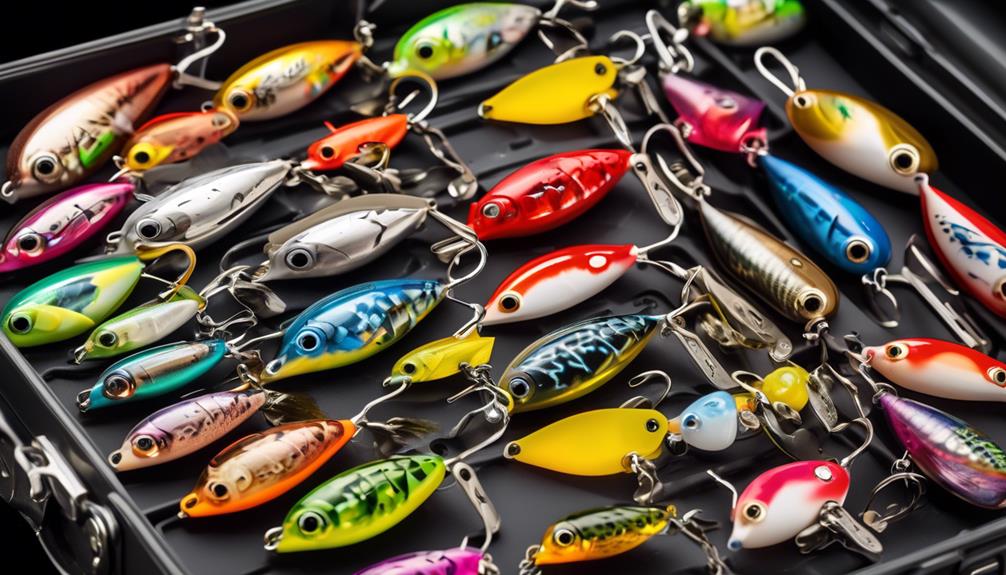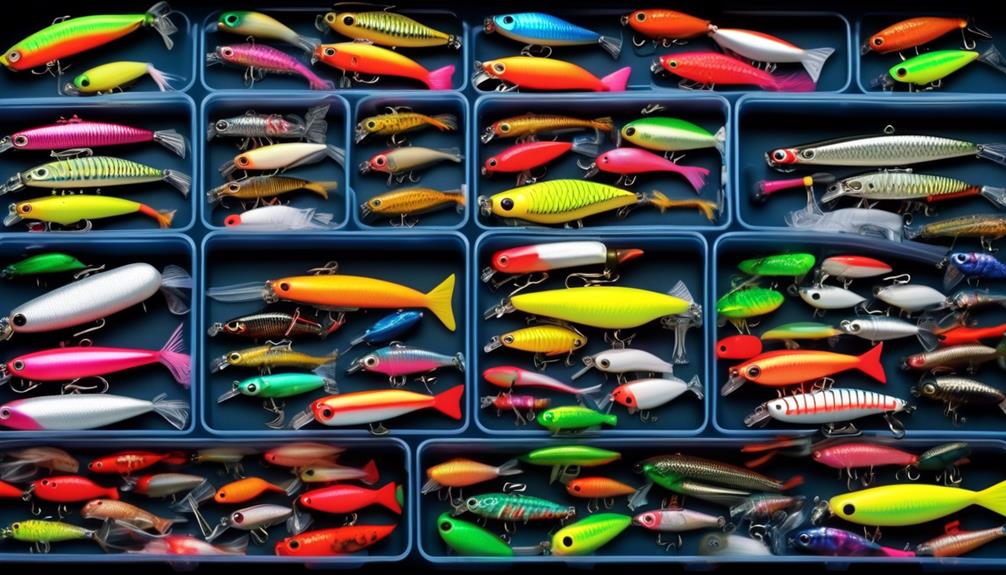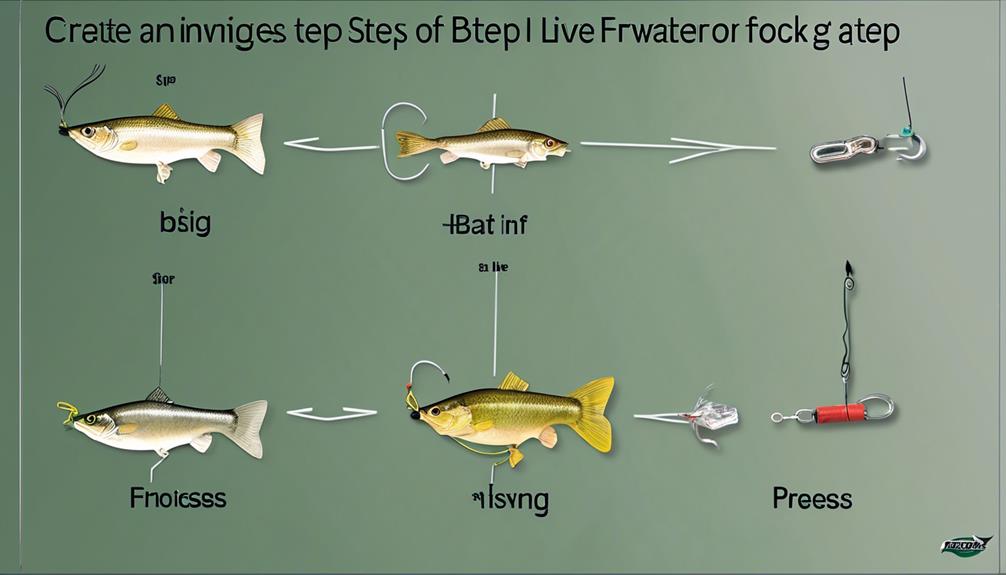You're about to discover the key to reeling in the big one on your next freshwater fishing trip. With the right lure, you'll have the advantage when it comes to enticing those elusive bass, pike, or trout.
But with so many options out there, how do you know which ones are truly the best? Let's explore the top 7 lures that are sure to up your fishing game and have you landing more catches than ever before.
Spinnerbaits
When targeting freshwater game fish, spinnerbaits are a versatile and effective lure choice due to their ability to attract strikes in various water conditions and depths. To maximize your success with spinnerbaits, it's crucial to understand the best techniques and locations for using them.
Spinnerbaits excel in covering water quickly, making them ideal for probing vast areas and finding active fish. They're particularly effective when fishing around shallow cover such as submerged grass, brush, or rocky shorelines. Try varying your retrieval speed to find the most effective presentation. Sometimes a slow and steady retrieve works best, while other times a fast and erratic retrieve can trigger aggressive strikes. Experimenting with different retrieval speeds will help you figure out what the fish are responding to on any given day.
Color selection is another important aspect when using spinnerbaits. In clear water, natural colors like shad, bluegill, or perch patterns often work well. In murky or stained water, brighter and bolder colors such as chartreuse, white, or firetiger can be more effective at grabbing the fish's attention. It's also essential to pay attention to the prevailing conditions. On cloudy days or in low light conditions, using darker colored spinnerbaits can help silhouette the lure and make it more visible to the fish. Conversely, on bright, sunny days, lighter colored spinnerbaits can mimic baitfish shimmering in the sunlight and attract more strikes.
Crankbaits
For successful freshwater fishing, incorporating crankbaits into your tackle box can significantly expand your ability to target and entice game fish. When it comes to crankbait techniques, mastering the art of varying your retrieval speed and incorporating pauses can make all the difference. The erratic movements of a crankbait mimicking a wounded baitfish can trigger aggressive strikes from bass and other predatory fish. Experiment with different depths by using crankbaits with varying lip sizes. Deeper diving crankbaits are great for targeting fish in deeper waters, while shallow diving ones work well in shallow areas or near the surface.
Crankbait color selection is another crucial factor in maximizing your fishing success. The general rule of thumb is to match the crankbait color with the water clarity. In clearer waters, natural and more translucent colors such as silver, shad, or perch tend to be more effective. In murkier waters, opt for brighter and bolder colors like chartreuse, firetiger, or red to enhance visibility. Additionally, consider the prevalent forage in the area. If the water is teeming with crawfish, using a crankbait with a red or brown pattern can mimic this natural prey and attract bites.
Jigs
To increase your chances of catching freshwater game fish, incorporate jigs into your tackle box and master the art of jigging to entice strikes. Jigs are incredibly versatile and effective lures for freshwater fishing. When it comes to jigging techniques, it's crucial to understand the underwater structure.
Target areas with submerged logs, rock formations, and drop-offs, as these are prime locations where game fish often lurk. Use a slow, steady retrieve and experiment with different jigging motions to mimic the movement of prey, such as crayfish or baitfish. Varying your jigging techniques can trigger more strikes from curious or hungry fish.
Jig color selection is another important aspect to consider. Choose jig colors based on the water conditions and the natural prey in the area. In murky or stained water, opt for brighter or contrasting colors to enhance visibility. In clear water, go for more natural and subtle hues to mimic the surroundings.
Depth variations are also key to successful jig fishing. Adjust the weight of your jig or use different jig sizes to reach various depths where fish might be holding. Understanding the depth at which the fish are feeding is essential for presenting the jig at the right level.
Soft Plastic Worms
Are you looking for a versatile and effective lure for freshwater fishing? Soft plastic worms are a go-to choice for many anglers due to their versatility and effectiveness in catching a wide range of freshwater fish species.
When it comes to rigging techniques for soft plastic worms, the Texas rig is a popular choice. This involves inserting the hook into the head of the worm and then sliding it out, allowing the point of the hook to be embedded in the body of the worm to make it weedless. Another effective rigging technique is the Carolina rig, which allows the worm to move more freely.
As for colors, when fishing in clear water, natural colors like green pumpkin or watermelon are often successful. In murky or stained water, darker colors such as black or blue can be more visible to fish.
In terms of retrieval methods, using scent and attractants can significantly enhance the effectiveness of soft plastic worms. Applying fish attractant to the soft plastic worm can help lure fish by adding scent and taste to the bait. When retrieving the worm, a slow and subtle approach often works best. This involves gently twitching the rod to impart a lifelike action to the worm, mimicking the movements of natural prey.
Topwater Lures
Soft plastic worms are a popular choice for many anglers, but if you want to try something different, consider exploring the exciting world of topwater lures. Topwater lures are designed to create surface action, mimicking the movement of prey on the water's surface. This type of lure can be incredibly effective in attracting predatory fish, as it presents a tantalizing target that triggers their hunting instincts.
When using topwater lures, it's essential to master topwater techniques to maximize your success. One effective technique is the 'walk-the-dog,' where you impart a side-to-side action on the lure, imitating a wounded or disoriented baitfish. This erratic movement often induces aggressive strikes from bass, pike, and other species lurking below. Another technique involves creating a commotion on the water's surface by rapidly retrieving the lure, simulating a fleeing or struggling prey. This can provoke explosive strikes from hungry fish, making for an exhilarating angling experience.
Topwater lures come in various forms, such as poppers, prop baits, and buzzbaits, each offering unique surface presentations to entice fish. Poppers produce a popping or splashing action when jerked, while prop baits feature spinning blades that churn the water, both creating irresistible disturbances. On the other hand, buzzbaits generate a buzzing noise and surface wake, drawing attention from nearby fish.
Incorporating topwater lures into your freshwater fishing arsenal can add an element of thrill and unpredictability to your angling endeavors, making every strike a heart-pounding moment of excitement.
Swimbaits
Consider adding swimbaits to your freshwater fishing repertoire for a dynamic and effective approach to enticing predatory fish. Swimbaits come in various styles and can be used with different retrieval techniques to mimic the movement of natural baitfish, making them a versatile option for anglers targeting bass, pike, muskie, and other game fish.
Here are a few swimbait styles to consider:
- Soft Plastic Swimbaits: These are highly realistic and come in various sizes and colors to imitate specific baitfish species. They're effective for slow and steady retrieves, as well as for vertical jigging.
- Hard Body Swimbaits: These lures have a more rigid body and are ideal for covering water quickly. They often feature jointed designs that create a lifelike swimming action, making them suitable for steady retrieves or erratic jerking motions.
- Multi-Jointed Swimbaits: With multiple segments, these swimbaits offer a natural S-shaped swimming motion. They work well with a slow, steady retrieve or a stop-and-go technique.
- Paddle Tail Swimbaits: These swimbaits have a distinct paddle-shaped tail that creates enticing vibrations and lifelike movement, making them effective for various retrieval speeds, including a steady retrieve or a pulsating action.
When using swimbaits, try different retrieval techniques such as steady retrieves, erratic jerking motions, or pausing to let the lure sink. Experimenting with these styles and techniques will help you determine the most effective approach based on the behavior of the fish and the prevailing conditions.
Spoon Lures

As you explore different lure options to enhance your freshwater fishing experience, let's now turn our attention to spoon lures, which offer a unique and effective approach for targeting a variety of game fish. Spoon lures are known for their ability to mimic the erratic movements of injured baitfish, making them irresistible to predatory fish.
When using spoon lures, mastering casting techniques and retrieval methods is crucial for success. To achieve maximum effectiveness, cast your spoon lure beyond your target area and reel it in at varying speeds, incorporating pauses and jerks to simulate the movements of a wounded prey. Experimenting with different retrieval methods will help you determine what works best for the specific fish species you're targeting.
Customization options and color selection are also essential when using spoon lures. Many spoon lures allow for customization by adding or removing hooks, changing the hook size, or adjusting the weight to suit different fishing conditions. When selecting the color of your spoon lure, consider the water clarity and the prevalent forage species in the area. In clear water, natural metallic finishes like chrome or silver can be effective, while in murky water, bright and contrasting colors may be more visible to fish.
Jerkbaits
When fishing with jerkbaits, you can create a realistic wounded baitfish action by using sharp jerks and pauses during retrieval. This technique imitates the erratic movements of injured prey, enticing freshwater game fish to strike.
Here are some tips to maximize your success with jerkbaits:
- Jerkbait Retrieval Techniques: Mastering the retrieval technique is crucial when using jerkbaits. After casting, reel in the slack and then use your rod to impart sharp jerks to the bait. These jerks should be followed by a pause, allowing the jerkbait to suspend in the water, mimicking a vulnerable baitfish. Vary the cadence of your jerks and pauses to find what triggers the most strikes.
- Jerkbait Color Selection: The color of your jerkbait can significantly impact its effectiveness. In clear water, natural and translucent colors like silver, white, or light green can be highly productive. In murky water or low light conditions, opt for brighter colors such as chartreuse or firetiger to increase visibility. Additionally, consider the local forage and match the color of your jerkbait to the prevalent baitfish species.
When using jerkbaits, remember to experiment with different retrieval techniques and carefully consider the color selection to adapt to varying water conditions and increase your chances of a successful freshwater fishing adventure.
Frequently Asked Questions
What Are the Best Techniques for Using Spinnerbaits in Different Water Conditions?
When using spinnerbaits in different water conditions, adjust the retrieval speed to match the water clarity. In clear water, use subtle, slow retrieves. Varying crankbait depth and presenting near underwater structure can also improve your success.
How Can I Effectively Use Crankbaits to Target Specific Freshwater Fish Species?
To effectively use crankbaits for specific freshwater fish species, focus on crankbait retrieval and casting accuracy. Seasonal bait selection and depth control are crucial. Vary your retrieval speed and experiment with different depths to find what works best.
Are There Any Special Tips for Rigging Jigs to Maximize Their Effectiveness in Different Types of Cover?
To maximize the effectiveness of your jig rigging in different types of cover, focus on a weedless setup. Also, pay attention to your jig presentation and depth control. These tips will help you catch more fish.
What Are Some Unique Ways to Rig Soft Plastic Worms for Freshwater Fishing?
To rig soft plastic worms for freshwater fishing, you can use a Texas rig, wacky rig, finesse rig, weightless rig, Carolina rig, or drop shot rig. Each offers unique benefits based on the fishing conditions.
Can You Provide Some Specific Tips for Using Topwater Lures to Attract Bass in Shallow Water?
When fishing for bass in shallow water, effective retrieval is key. Choose topwater lures that mimic natural prey. Use walking or popping techniques to attract strikes. Experiment with different lure colors and sizes for successful bass fishing.
Conclusion
So next time you head out for some freshwater fishing, make sure to pack these 7 best lures in your tackle box.
With the right lures, you can increase your chances of a successful catch and have a great day on the water.
Happy fishing!



